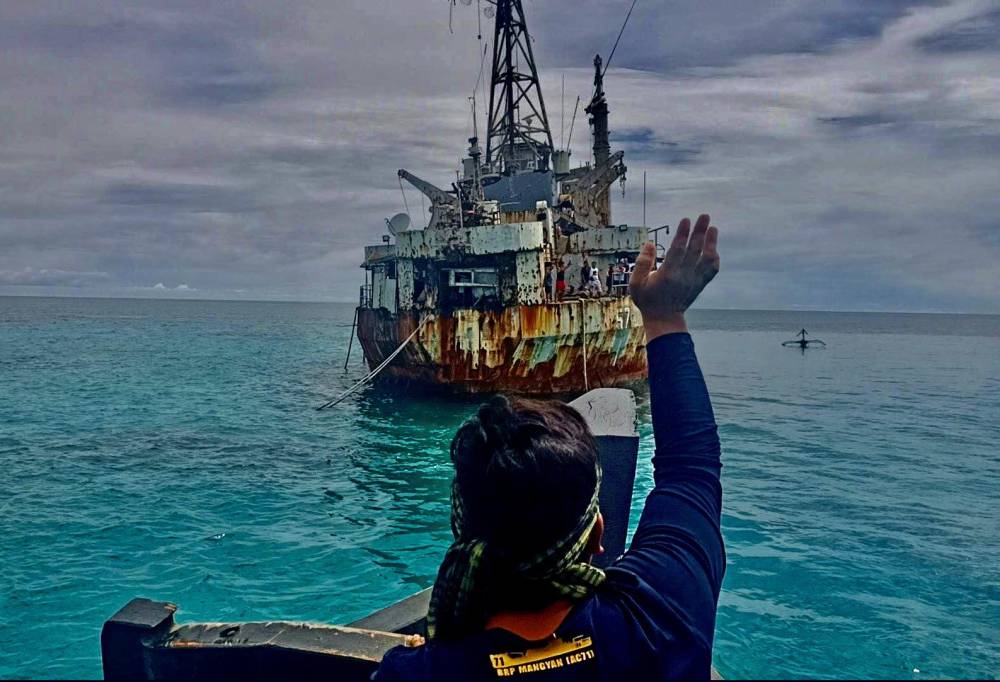At A Glance
- BRP Sierra Madre (LS57), a commissioned vessel of the Philippine Navy, has a daunting task to protect the country and its people.
- The BRP Sierra Madre was acquired by the Navy in 1976 and was named after the Sierra Madre Mountain Range, the longest mountain range in the country.
- In 1999, BRP Sierra Madre was deliberately ran aground on Ayungin Shoal to serve as a permanent military outpost by the Armed Forces of the Philippines (AFP) and assert the country's sovereign rights in the area. This, after China occupied Panganiban "Mischief" Reef near Ayungin Shoal in 1995.
- Food, water, and other supplies are being brought to the AFP personnel onboard BRP Sierra Madre through a rotation and reprovision mission (RORE) by the Palawan-based WesCom every six months or if their supplies are already exhausted.
Just like the famed mountain range from where its name was derived, BRP Sierra Madre (LS57), a commissioned vessel of the Philippine Navy, has a daunting task to protect the country and its people.

The BRP Sierra Madre was acquired by the Navy in 1976 and was named after the Sierra Madre Mountain Range, the longest mountain range in the country. Now it is at the center of the ongoing maritime and diplomatic tussle between the Philippines and China at the Ayungin (Second Thomas) Shoal.
While Sierra Madre mountain range is called the “backbone of Luzon” as it protects the island from countless of typhoons, BRP Sierra Madre provides shelter and vision to dozens of Marines and Navy personnel who are living onboard the vessel.
Life at sea
BRP Sierra Madre was originally a World War II era tank landing ship of the United States Navy before it was transferred to Vietnam, and then the Philippines.
The vessel had been used to patrol the Kalayaan Island Group (KIG) in Palawan but oftentimes, it would hit the shallow waters of Ayungin Shoal. The atoll is located some 106 nautical miles from Palawan within the Philippines’ 200 nautical mile exclusive economic zone (EEZ) but it is also being claimed by China, which has a distance of around 600 nautical miles from its nearest point.
The shoal was about three to four meters deep and only small boats can access and get close to it.
In 1999, BRP Sierra Madre was deliberately ran aground on Ayungin Shoal to serve as a permanent military outpost by the Armed Forces of the Philippines (AFP) and assert the country’s sovereign rights in the area.
This, after China occupied Panganiban “Mischief” Reef near Ayungin Shoal in 1995.
Panganiban Reef is located at approximately 130 nautical miles from Palawan. To date, Panganiban Reef is China’s closest military facility to Palawan.
“BRP Sierra Madre remains an active vessel of the Philippine Navy. Therefore, it is our responsibility to man it and to maintain it. We have to make sure that BRP Sierra Madre remains to be liveable and provides safe, living environment for our troops,” Col. Medel Aguilar said.
However, the Navy and Marines onboard BRP Sierra Madre have to face the harsh reality of BRP Sierra Madre’s current state.
Since it was sitting on the waters of Ayungin Shoal for 24 years already, rust is eating the ship and its dilapidated state only adds to the dangers faced by the AFP personnel amid the presence of Chinese vessels nearby.
Lt. Col. Isagani Nato, acting public information officer of the Western Command (WesCom), could not give the exact number of the AFP personnel onboard the BRP Sierra Madre and the name of the commanding officer of the vessel due to “operational matters” but he assured that the troops “are doing well.”
Food, water, and other supplies are being brought to the AFP personnel onboard BRP Sierra Madre through a rotation and reprovision mission (RORE) by the Palawan-based WesCom every six months or if their supplies are already exhausted.
But the latest RORE mission to Ayungin Shoal last August 5 was deemed “unsuccessful” after dozens of China Coast Guard (CCG), People’s Liberation Army (PLA) Navy, and Chinese maritime militia (CMM) vessels formed a blockade, made dangerous maneuvers, and fired water cannons at two supply boats manned by Filipino soldiers and escorted by two Philippine Coast Guard (PCG) near Ayungin Shoal.
Only one of the two supply boats managed to reach Ayungin Shoal due to the incident.
“They are okay but sinnce only half of the supplies are delivered to our troops, we need another a refurbishment or resupply mission. The supplies will be enough for them for now,” Nato said.
Fixing BRP Sierra Madre
After China's recent aggression, calls were made left and right to fund the military’s refurbishment of the BRP Sierra Madre to maintain its position in Ayungin Shoal.
Such calls were welcomed by the AFP and the National Task Force for the West Philippine Sea (NTF-WPS).
“We will not abandon BRP Sierra Madre. Kahit magpatintero tayo araw-araw (Even if we play cat and mouse there), we will continue to support and supply our troops. BRP Sierra Madre is a symbol of Philipine sovereignty over that area,” said NTF-WPS spokesperson Jonathan Malaya.
“Our AFP in Palawan will continue to do its tasks in pursuit of securing our people, our territory and our national interest particularly in the West Philippine Sea. Together with the local government unit and people of Palawan, the Team WESCOM will remain vigilant and steadfast to fulfill its mandate of protecting the sovereignty, sovereign rights in the EEZ, and territorial integrity within its area of responsibility,” added WESCOM spokesman Nato.